Case Study: Ulcerative Colitis, Patient History and Interventions
VerifiedAdded on 2023/04/20
|6
|1615
|129
Case Study
AI Summary
This case study examines a 48-year-old patient, Eleanor Brown, who has been hospitalized due to complications from ulcerative colitis. Diagnosed at age 31, Eleanor has a history of hospital admissions for acute episodes managed through diet, medication (infliximab), and medical monitoring. The current exacerbation involves frequent bloody diarrhea, severe abdominal pain, and weight loss. The analysis covers the pathophysiology of weight loss in ulcerative colitis, the pain pathway and effectiveness of opioid analgesics like morphine, observable clinical features and alarming signs, and the rationale behind using Hartmann's solution to replenish fluids and electrolytes. The solution discusses the impact of inflammation, malabsorption, and the rare condition of pancolitis on the patient's condition, providing a comprehensive overview of the patient's management and treatment.

Case Study Assessment
University
Unit
Name
Tutor
Date
University
Unit
Name
Tutor
Date
Paraphrase This Document
Need a fresh take? Get an instant paraphrase of this document with our AI Paraphraser
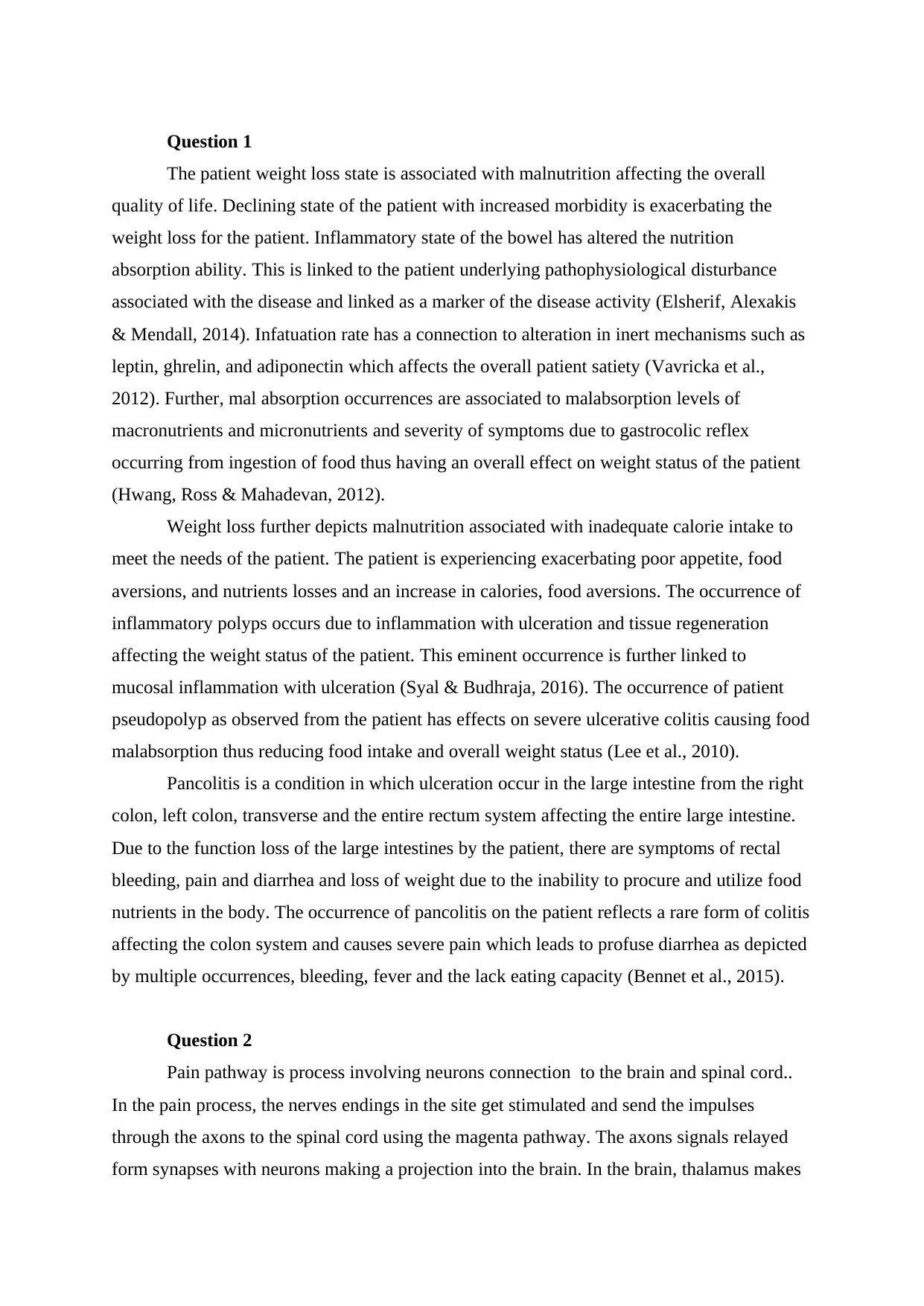
Question 1
The patient weight loss state is associated with malnutrition affecting the overall
quality of life. Declining state of the patient with increased morbidity is exacerbating the
weight loss for the patient. Inflammatory state of the bowel has altered the nutrition
absorption ability. This is linked to the patient underlying pathophysiological disturbance
associated with the disease and linked as a marker of the disease activity (Elsherif, Alexakis
& Mendall, 2014). Infatuation rate has a connection to alteration in inert mechanisms such as
leptin, ghrelin, and adiponectin which affects the overall patient satiety (Vavricka et al.,
2012). Further, mal absorption occurrences are associated to malabsorption levels of
macronutrients and micronutrients and severity of symptoms due to gastrocolic reflex
occurring from ingestion of food thus having an overall effect on weight status of the patient
(Hwang, Ross & Mahadevan, 2012).
Weight loss further depicts malnutrition associated with inadequate calorie intake to
meet the needs of the patient. The patient is experiencing exacerbating poor appetite, food
aversions, and nutrients losses and an increase in calories, food aversions. The occurrence of
inflammatory polyps occurs due to inflammation with ulceration and tissue regeneration
affecting the weight status of the patient. This eminent occurrence is further linked to
mucosal inflammation with ulceration (Syal & Budhraja, 2016). The occurrence of patient
pseudopolyp as observed from the patient has effects on severe ulcerative colitis causing food
malabsorption thus reducing food intake and overall weight status (Lee et al., 2010).
Pancolitis is a condition in which ulceration occur in the large intestine from the right
colon, left colon, transverse and the entire rectum system affecting the entire large intestine.
Due to the function loss of the large intestines by the patient, there are symptoms of rectal
bleeding, pain and diarrhea and loss of weight due to the inability to procure and utilize food
nutrients in the body. The occurrence of pancolitis on the patient reflects a rare form of colitis
affecting the colon system and causes severe pain which leads to profuse diarrhea as depicted
by multiple occurrences, bleeding, fever and the lack eating capacity (Bennet et al., 2015).
Question 2
Pain pathway is process involving neurons connection to the brain and spinal cord..
In the pain process, the nerves endings in the site get stimulated and send the impulses
through the axons to the spinal cord using the magenta pathway. The axons signals relayed
form synapses with neurons making a projection into the brain. In the brain, thalamus makes
The patient weight loss state is associated with malnutrition affecting the overall
quality of life. Declining state of the patient with increased morbidity is exacerbating the
weight loss for the patient. Inflammatory state of the bowel has altered the nutrition
absorption ability. This is linked to the patient underlying pathophysiological disturbance
associated with the disease and linked as a marker of the disease activity (Elsherif, Alexakis
& Mendall, 2014). Infatuation rate has a connection to alteration in inert mechanisms such as
leptin, ghrelin, and adiponectin which affects the overall patient satiety (Vavricka et al.,
2012). Further, mal absorption occurrences are associated to malabsorption levels of
macronutrients and micronutrients and severity of symptoms due to gastrocolic reflex
occurring from ingestion of food thus having an overall effect on weight status of the patient
(Hwang, Ross & Mahadevan, 2012).
Weight loss further depicts malnutrition associated with inadequate calorie intake to
meet the needs of the patient. The patient is experiencing exacerbating poor appetite, food
aversions, and nutrients losses and an increase in calories, food aversions. The occurrence of
inflammatory polyps occurs due to inflammation with ulceration and tissue regeneration
affecting the weight status of the patient. This eminent occurrence is further linked to
mucosal inflammation with ulceration (Syal & Budhraja, 2016). The occurrence of patient
pseudopolyp as observed from the patient has effects on severe ulcerative colitis causing food
malabsorption thus reducing food intake and overall weight status (Lee et al., 2010).
Pancolitis is a condition in which ulceration occur in the large intestine from the right
colon, left colon, transverse and the entire rectum system affecting the entire large intestine.
Due to the function loss of the large intestines by the patient, there are symptoms of rectal
bleeding, pain and diarrhea and loss of weight due to the inability to procure and utilize food
nutrients in the body. The occurrence of pancolitis on the patient reflects a rare form of colitis
affecting the colon system and causes severe pain which leads to profuse diarrhea as depicted
by multiple occurrences, bleeding, fever and the lack eating capacity (Bennet et al., 2015).
Question 2
Pain pathway is process involving neurons connection to the brain and spinal cord..
In the pain process, the nerves endings in the site get stimulated and send the impulses
through the axons to the spinal cord using the magenta pathway. The axons signals relayed
form synapses with neurons making a projection into the brain. In the brain, thalamus makes
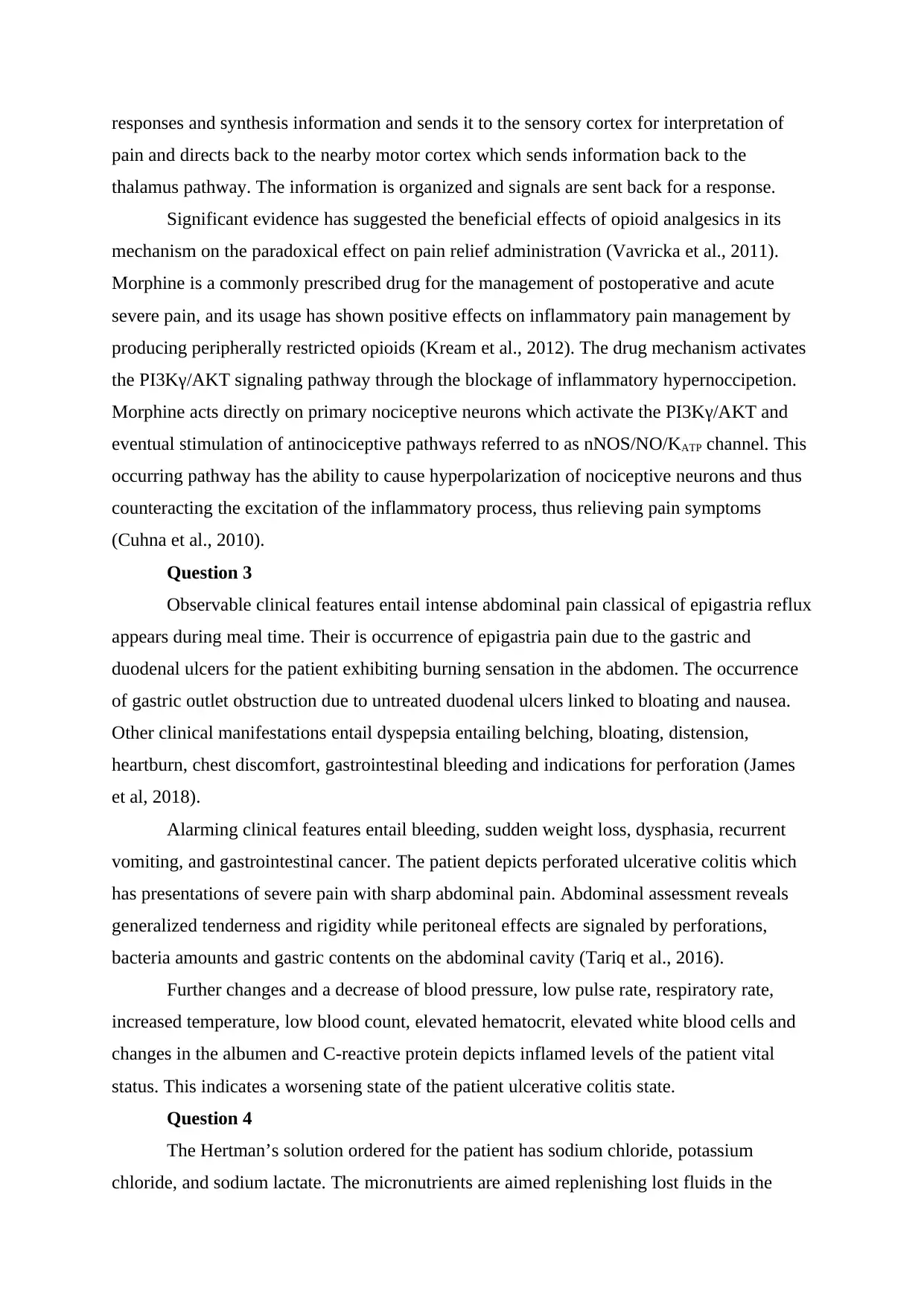
responses and synthesis information and sends it to the sensory cortex for interpretation of
pain and directs back to the nearby motor cortex which sends information back to the
thalamus pathway. The information is organized and signals are sent back for a response.
Significant evidence has suggested the beneficial effects of opioid analgesics in its
mechanism on the paradoxical effect on pain relief administration (Vavricka et al., 2011).
Morphine is a commonly prescribed drug for the management of postoperative and acute
severe pain, and its usage has shown positive effects on inflammatory pain management by
producing peripherally restricted opioids (Kream et al., 2012). The drug mechanism activates
the PI3Kγ/AKT signaling pathway through the blockage of inflammatory hypernoccipetion.
Morphine acts directly on primary nociceptive neurons which activate the PI3Kγ/AKT and
eventual stimulation of antinociceptive pathways referred to as nNOS/NO/KATP channel. This
occurring pathway has the ability to cause hyperpolarization of nociceptive neurons and thus
counteracting the excitation of the inflammatory process, thus relieving pain symptoms
(Cuhna et al., 2010).
Question 3
Observable clinical features entail intense abdominal pain classical of epigastria reflux
appears during meal time. Their is occurrence of epigastria pain due to the gastric and
duodenal ulcers for the patient exhibiting burning sensation in the abdomen. The occurrence
of gastric outlet obstruction due to untreated duodenal ulcers linked to bloating and nausea.
Other clinical manifestations entail dyspepsia entailing belching, bloating, distension,
heartburn, chest discomfort, gastrointestinal bleeding and indications for perforation (James
et al, 2018).
Alarming clinical features entail bleeding, sudden weight loss, dysphasia, recurrent
vomiting, and gastrointestinal cancer. The patient depicts perforated ulcerative colitis which
has presentations of severe pain with sharp abdominal pain. Abdominal assessment reveals
generalized tenderness and rigidity while peritoneal effects are signaled by perforations,
bacteria amounts and gastric contents on the abdominal cavity (Tariq et al., 2016).
Further changes and a decrease of blood pressure, low pulse rate, respiratory rate,
increased temperature, low blood count, elevated hematocrit, elevated white blood cells and
changes in the albumen and C-reactive protein depicts inflamed levels of the patient vital
status. This indicates a worsening state of the patient ulcerative colitis state.
Question 4
The Hertman’s solution ordered for the patient has sodium chloride, potassium
chloride, and sodium lactate. The micronutrients are aimed replenishing lost fluids in the
pain and directs back to the nearby motor cortex which sends information back to the
thalamus pathway. The information is organized and signals are sent back for a response.
Significant evidence has suggested the beneficial effects of opioid analgesics in its
mechanism on the paradoxical effect on pain relief administration (Vavricka et al., 2011).
Morphine is a commonly prescribed drug for the management of postoperative and acute
severe pain, and its usage has shown positive effects on inflammatory pain management by
producing peripherally restricted opioids (Kream et al., 2012). The drug mechanism activates
the PI3Kγ/AKT signaling pathway through the blockage of inflammatory hypernoccipetion.
Morphine acts directly on primary nociceptive neurons which activate the PI3Kγ/AKT and
eventual stimulation of antinociceptive pathways referred to as nNOS/NO/KATP channel. This
occurring pathway has the ability to cause hyperpolarization of nociceptive neurons and thus
counteracting the excitation of the inflammatory process, thus relieving pain symptoms
(Cuhna et al., 2010).
Question 3
Observable clinical features entail intense abdominal pain classical of epigastria reflux
appears during meal time. Their is occurrence of epigastria pain due to the gastric and
duodenal ulcers for the patient exhibiting burning sensation in the abdomen. The occurrence
of gastric outlet obstruction due to untreated duodenal ulcers linked to bloating and nausea.
Other clinical manifestations entail dyspepsia entailing belching, bloating, distension,
heartburn, chest discomfort, gastrointestinal bleeding and indications for perforation (James
et al, 2018).
Alarming clinical features entail bleeding, sudden weight loss, dysphasia, recurrent
vomiting, and gastrointestinal cancer. The patient depicts perforated ulcerative colitis which
has presentations of severe pain with sharp abdominal pain. Abdominal assessment reveals
generalized tenderness and rigidity while peritoneal effects are signaled by perforations,
bacteria amounts and gastric contents on the abdominal cavity (Tariq et al., 2016).
Further changes and a decrease of blood pressure, low pulse rate, respiratory rate,
increased temperature, low blood count, elevated hematocrit, elevated white blood cells and
changes in the albumen and C-reactive protein depicts inflamed levels of the patient vital
status. This indicates a worsening state of the patient ulcerative colitis state.
Question 4
The Hertman’s solution ordered for the patient has sodium chloride, potassium
chloride, and sodium lactate. The micronutrients are aimed replenishing lost fluids in the
⊘ This is a preview!⊘
Do you want full access?
Subscribe today to unlock all pages.

Trusted by 1+ million students worldwide
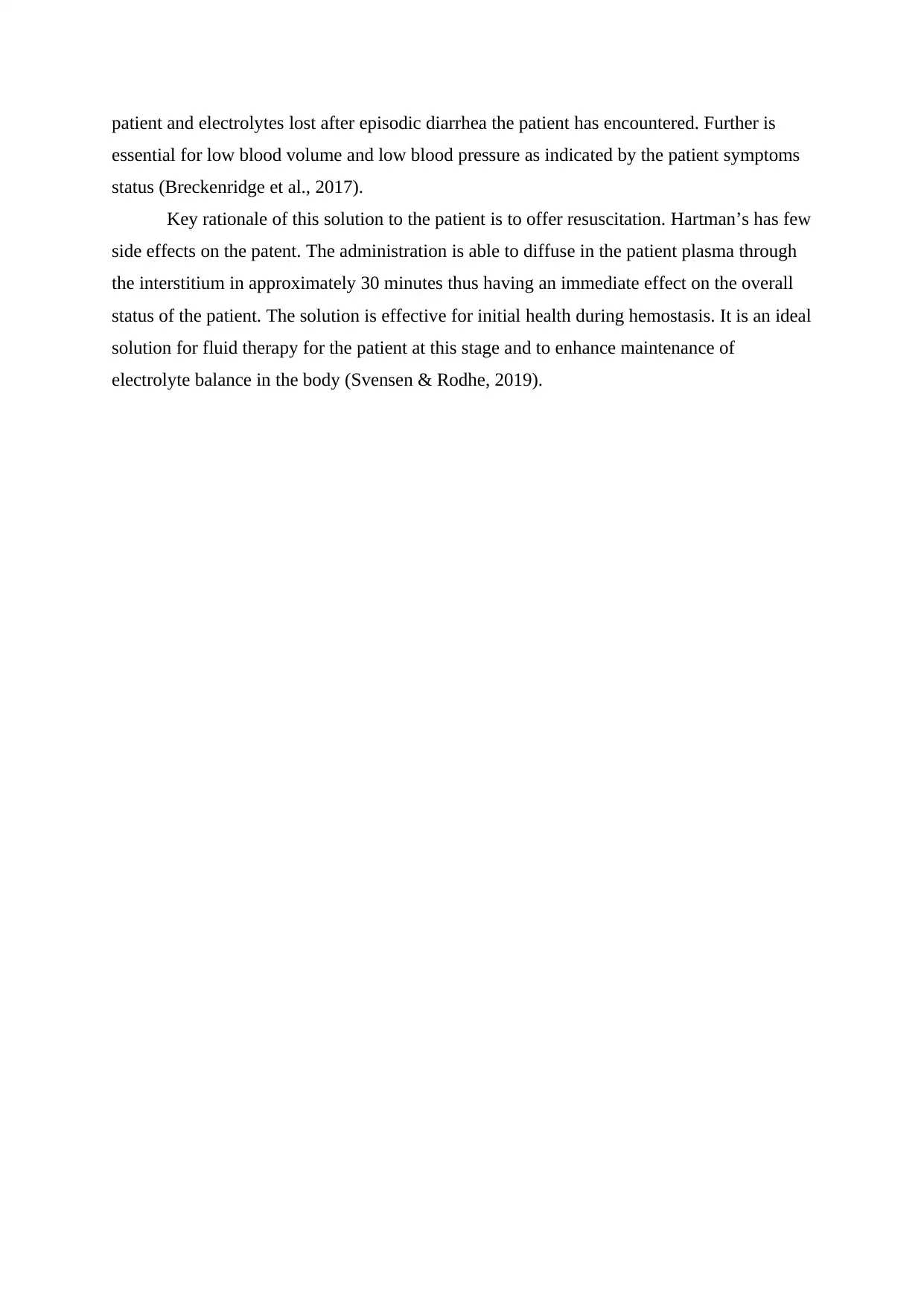
patient and electrolytes lost after episodic diarrhea the patient has encountered. Further is
essential for low blood volume and low blood pressure as indicated by the patient symptoms
status (Breckenridge et al., 2017).
Key rationale of this solution to the patient is to offer resuscitation. Hartman’s has few
side effects on the patent. The administration is able to diffuse in the patient plasma through
the interstitium in approximately 30 minutes thus having an immediate effect on the overall
status of the patient. The solution is effective for initial health during hemostasis. It is an ideal
solution for fluid therapy for the patient at this stage and to enhance maintenance of
electrolyte balance in the body (Svensen & Rodhe, 2019).
essential for low blood volume and low blood pressure as indicated by the patient symptoms
status (Breckenridge et al., 2017).
Key rationale of this solution to the patient is to offer resuscitation. Hartman’s has few
side effects on the patent. The administration is able to diffuse in the patient plasma through
the interstitium in approximately 30 minutes thus having an immediate effect on the overall
status of the patient. The solution is effective for initial health during hemostasis. It is an ideal
solution for fluid therapy for the patient at this stage and to enhance maintenance of
electrolyte balance in the body (Svensen & Rodhe, 2019).
Paraphrase This Document
Need a fresh take? Get an instant paraphrase of this document with our AI Paraphraser
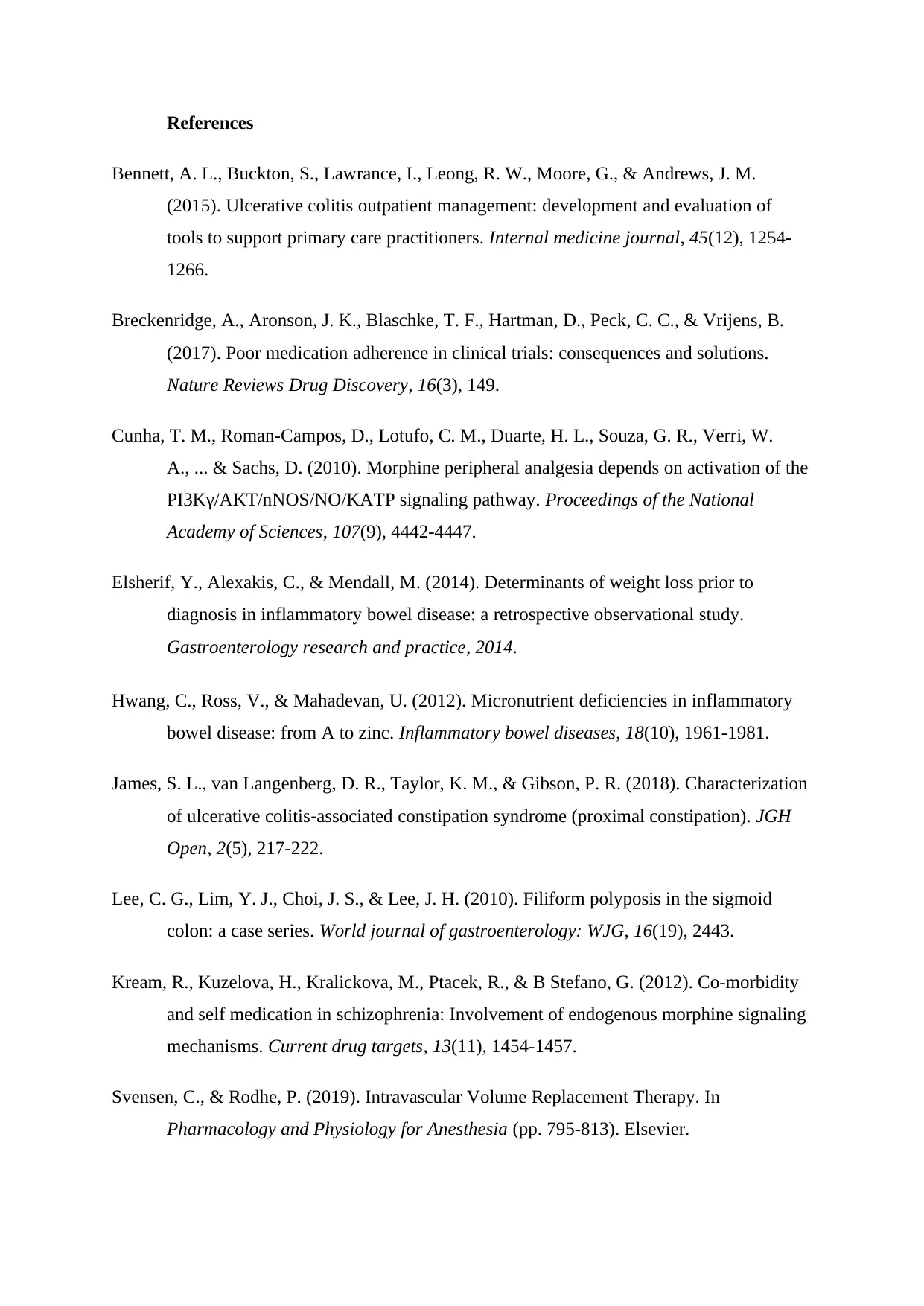
References
Bennett, A. L., Buckton, S., Lawrance, I., Leong, R. W., Moore, G., & Andrews, J. M.
(2015). Ulcerative colitis outpatient management: development and evaluation of
tools to support primary care practitioners. Internal medicine journal, 45(12), 1254-
1266.
Breckenridge, A., Aronson, J. K., Blaschke, T. F., Hartman, D., Peck, C. C., & Vrijens, B.
(2017). Poor medication adherence in clinical trials: consequences and solutions.
Nature Reviews Drug Discovery, 16(3), 149.
Cunha, T. M., Roman-Campos, D., Lotufo, C. M., Duarte, H. L., Souza, G. R., Verri, W.
A., ... & Sachs, D. (2010). Morphine peripheral analgesia depends on activation of the
PI3Kγ/AKT/nNOS/NO/KATP signaling pathway. Proceedings of the National
Academy of Sciences, 107(9), 4442-4447.
Elsherif, Y., Alexakis, C., & Mendall, M. (2014). Determinants of weight loss prior to
diagnosis in inflammatory bowel disease: a retrospective observational study.
Gastroenterology research and practice, 2014.
Hwang, C., Ross, V., & Mahadevan, U. (2012). Micronutrient deficiencies in inflammatory
bowel disease: from A to zinc. Inflammatory bowel diseases, 18(10), 1961-1981.
James, S. L., van Langenberg, D. R., Taylor, K. M., & Gibson, P. R. (2018). Characterization
of ulcerative colitis‐associated constipation syndrome (proximal constipation). JGH
Open, 2(5), 217-222.
Lee, C. G., Lim, Y. J., Choi, J. S., & Lee, J. H. (2010). Filiform polyposis in the sigmoid
colon: a case series. World journal of gastroenterology: WJG, 16(19), 2443.
Kream, R., Kuzelova, H., Kralickova, M., Ptacek, R., & B Stefano, G. (2012). Co-morbidity
and self medication in schizophrenia: Involvement of endogenous morphine signaling
mechanisms. Current drug targets, 13(11), 1454-1457.
Svensen, C., & Rodhe, P. (2019). Intravascular Volume Replacement Therapy. In
Pharmacology and Physiology for Anesthesia (pp. 795-813). Elsevier.
Bennett, A. L., Buckton, S., Lawrance, I., Leong, R. W., Moore, G., & Andrews, J. M.
(2015). Ulcerative colitis outpatient management: development and evaluation of
tools to support primary care practitioners. Internal medicine journal, 45(12), 1254-
1266.
Breckenridge, A., Aronson, J. K., Blaschke, T. F., Hartman, D., Peck, C. C., & Vrijens, B.
(2017). Poor medication adherence in clinical trials: consequences and solutions.
Nature Reviews Drug Discovery, 16(3), 149.
Cunha, T. M., Roman-Campos, D., Lotufo, C. M., Duarte, H. L., Souza, G. R., Verri, W.
A., ... & Sachs, D. (2010). Morphine peripheral analgesia depends on activation of the
PI3Kγ/AKT/nNOS/NO/KATP signaling pathway. Proceedings of the National
Academy of Sciences, 107(9), 4442-4447.
Elsherif, Y., Alexakis, C., & Mendall, M. (2014). Determinants of weight loss prior to
diagnosis in inflammatory bowel disease: a retrospective observational study.
Gastroenterology research and practice, 2014.
Hwang, C., Ross, V., & Mahadevan, U. (2012). Micronutrient deficiencies in inflammatory
bowel disease: from A to zinc. Inflammatory bowel diseases, 18(10), 1961-1981.
James, S. L., van Langenberg, D. R., Taylor, K. M., & Gibson, P. R. (2018). Characterization
of ulcerative colitis‐associated constipation syndrome (proximal constipation). JGH
Open, 2(5), 217-222.
Lee, C. G., Lim, Y. J., Choi, J. S., & Lee, J. H. (2010). Filiform polyposis in the sigmoid
colon: a case series. World journal of gastroenterology: WJG, 16(19), 2443.
Kream, R., Kuzelova, H., Kralickova, M., Ptacek, R., & B Stefano, G. (2012). Co-morbidity
and self medication in schizophrenia: Involvement of endogenous morphine signaling
mechanisms. Current drug targets, 13(11), 1454-1457.
Svensen, C., & Rodhe, P. (2019). Intravascular Volume Replacement Therapy. In
Pharmacology and Physiology for Anesthesia (pp. 795-813). Elsevier.
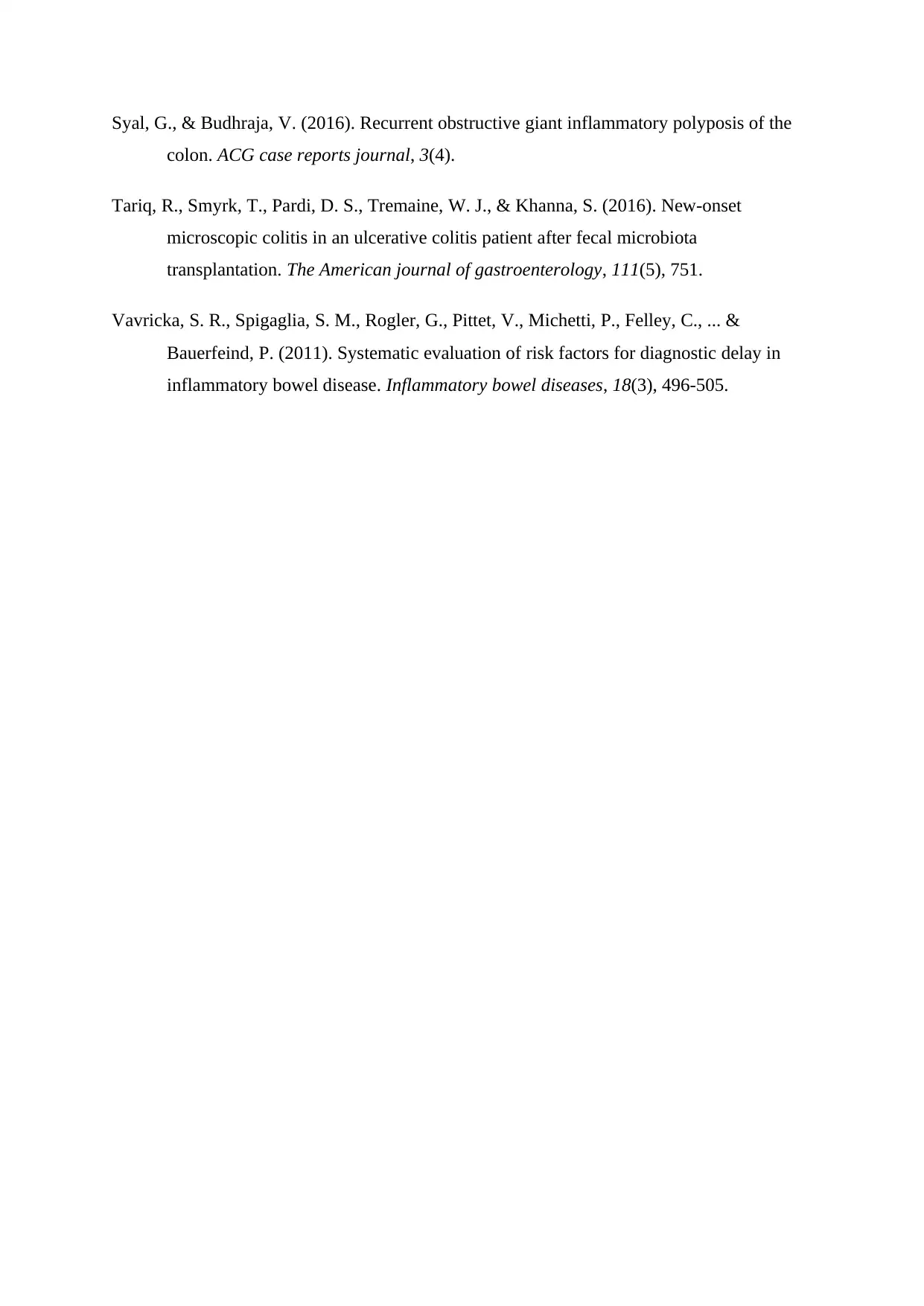
Syal, G., & Budhraja, V. (2016). Recurrent obstructive giant inflammatory polyposis of the
colon. ACG case reports journal, 3(4).
Tariq, R., Smyrk, T., Pardi, D. S., Tremaine, W. J., & Khanna, S. (2016). New-onset
microscopic colitis in an ulcerative colitis patient after fecal microbiota
transplantation. The American journal of gastroenterology, 111(5), 751.
Vavricka, S. R., Spigaglia, S. M., Rogler, G., Pittet, V., Michetti, P., Felley, C., ... &
Bauerfeind, P. (2011). Systematic evaluation of risk factors for diagnostic delay in
inflammatory bowel disease. Inflammatory bowel diseases, 18(3), 496-505.
colon. ACG case reports journal, 3(4).
Tariq, R., Smyrk, T., Pardi, D. S., Tremaine, W. J., & Khanna, S. (2016). New-onset
microscopic colitis in an ulcerative colitis patient after fecal microbiota
transplantation. The American journal of gastroenterology, 111(5), 751.
Vavricka, S. R., Spigaglia, S. M., Rogler, G., Pittet, V., Michetti, P., Felley, C., ... &
Bauerfeind, P. (2011). Systematic evaluation of risk factors for diagnostic delay in
inflammatory bowel disease. Inflammatory bowel diseases, 18(3), 496-505.
⊘ This is a preview!⊘
Do you want full access?
Subscribe today to unlock all pages.

Trusted by 1+ million students worldwide
1 out of 6
Related Documents
Your All-in-One AI-Powered Toolkit for Academic Success.
+13062052269
info@desklib.com
Available 24*7 on WhatsApp / Email
![[object Object]](/_next/static/media/star-bottom.7253800d.svg)
Unlock your academic potential
Copyright © 2020–2025 A2Z Services. All Rights Reserved. Developed and managed by ZUCOL.





